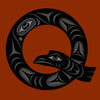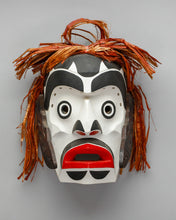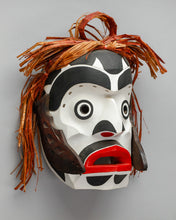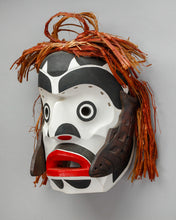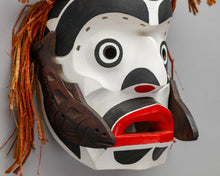Salmon Man Mask by Chief Sam Johnson, Kwakwaka'wakw
Regular price
$0.00
Sale
Salmon Man Mask, c. 1990
Chief Sam Johnson, Kwakwaka'wakw First Nation
red cedar, cedar bark, pigment
15" high x 9" wide x 8" deep
In Kwakwaka’wakw First Nation traditional belief, Salmon are supernatural beings who wear a Salmon Mask. In their world, when they remove this mask, they are human. In their salmon form, they do not die, rather pass through an endless cycle of birth, death, and resurrection, requiring the ocean (their water of life) for their rebirth and their return migration to their land.
Each year, as a gift to humans, salmon were believed to don their salmon masks and begin their migration. They were greeted by fishers as supernatural beings and “Bringers of Life," and they were offered prayers of thanks and respect. By late spring, migrating salmon begin to arrive in huge numbers. Because fish runs are “highly localized” both in time and space, it was necessary for Kwakwaka'wakw villages to come together and to cooperate in order to maximize the catch. This was essential for a good season of preservation ensuring a bountiful winter and a vigorous winter ceremonial.
Sam Johnson was born 1935 in Kingcome Inlet, British Columbia. Sam is a member of the Kwikwasut’inuxw Haxwa’mis First Nation (Kwakwaka’wakw Peoples), and was the son of the master carver Chief Herbert Johnson. Upon meeting his wife Lena, he moved to Gilford Island where he remained for over forty years. There he began his carving career began.
Sam works in the traditional Kwakwaka’wakw style using only hand made tools, and finishing his masks with knife cuts rather than sand paper. He carved the “Greeting Totem Poles,” along the shoreline, as well as many carvings in the “Big House” in Gilford Island. The Seattle Art Museum has a large collection of Sam Johnson’s masks depicting the animal kingdom.
Sam and Lena had three sons, Rick, Charlie, and Sandy, all of whom carried on the carving traditions of their father. As well, he was a great influence and teacher to many of the the current Kwakwaka’wakw carvers including Peter Smith and Don Svanvik.
As the oldest son, Sam moved into the head seat and became chief of his band after the passing of his father.
